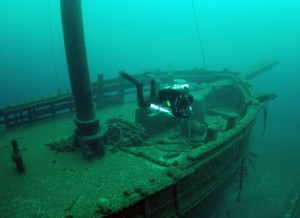Wisconsin Shipwreck Coast National Marine Sanctuary

A diver swims over the two-masted schooner Walter B. Allen, which sank in Lake Michigan 1880.
Credit: Tamara Thomsen, Wisconsin Historical Society
Off the lakeshore in Wisconsin, dozens of ships lie under the surface. In October 2015, the National Oceanic and Atmospheric Administration (NOAA) announced a new national marine sanctuary. In June 2021, the NOAA officially designated the Wisconsin Shipwreck Coast National Marine Sanctuary in Lake Michigan. Marine sanctuaries are protected waters, habitats, and archeological sites. In this case, NOAA’s sanctuary protects archeological, cultural, historic, and prehistoric artifacts, along with all historic shipwreck sites that served an important role in maritime heritage. The NOAA and the state of Wisconsin are co-managing the sanctuary.
The area is 726 square nautical miles (962 square miles or 2,492 square kilometers) along the coasts of Manitowoc, Port Washington, Sheboygan, and Two Rivers. The sanctuary protects 36 known shipwrecks. Of those, 21 are in the National Register of Historic Places. Because of Lake Michigan’s cold temperature and lack of salt, these shipwrecks are preserved with more integrity than usual, and some remain mostly intact. Researchers believe there are up to 59 shipwrecks in the sanctuary. Wisconsin spent three decades preserving historic maritime sites against human and natural activities. The sanctuary provides opportunities for archeological preservation, research, and education.
The shipwrecks have historical significance. They include the two oldest known shipwrecks in Wisconsin. From the 1800’s through the 1900’s, the Great Lakes were used to ship such goods as coal, grain, and manufactured goods. Hundreds of thousands of settlers used the lakes to move to the Midwest and West of the United States. Midwestern cities, farms, and industries grew as a result.


